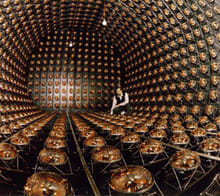The Liquid Scintillator Neutrino Detector (LSND) experiment involved the amassed data collected between the years of 1993-1998 designed to measure the number of neutrinos being produced by an accelerator neutrino source. It consisted of a tank filled with 167 tons (50,000 gallons) of mineral oil, 14 pounds of b-PDB (butyl-phenyl-bipheny-oxydiazole) organic scintillator material, and an array of 1220 photomultiplier tubes. The results were controversial and provided evidence supporting the theory of neutrino oscillation which suggested that muon anti-neutrinos oscillate into electron anti-neutrinos. It also, when combined with other data on neutrino oscillations, indicated the possibility that neutrinos represent roughly one percent or more of the universe’s total mass.

During the collection period from 1993-1998, LANSCE delivered 180 trillion-billion (180,000,000,000,000,000,000,000) protons to the LSND target. During this time, scientists found it difficult to reconcile the differences between the expected number of neutrinos (example the solar neutrino experiment mentioned on the timeline) and the actual number of neutrinos measured. The proposed explanation to this discrepancy was that neutrinos are not without mass, as was previously believed, and do not move at the speed of light. If they were to be able to move at the speed of light then the neutrinos would be locked into their “flavor” for the duration of their lifetime. If, however, neutrinos do have mass and move at a speed less than the speed of light, then over time they might oscillate between all three flavors: electron, muon, and tau. This would mean that each experiment which is able to only perceive one or two of the types, should achieve results that are 1/3 of the expected number of neutrinos.